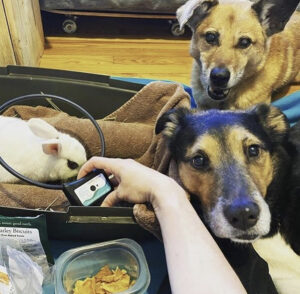
Rebecca Gridley is the founder and owner of Total Pet Training LLC, which offers training and behavior modification guidance using humane and safe methods.
AAH: Tell us about your background as a veterinary technician and animal rescuer. How did this work inspire you to establish Total Pet Training LLC?
RG: Many years ago when looking to work with animals and possibly pursue a career in veterinary medicine, I started work as a veterinary technician, and it was definitely hard but rewarding work. I stuck with that for many years. The longer I worked in the veterinary medical field, the more I had exposure to rescues and animals needing some extra help on their rehoming journeys. From there it was a pretty organic flow into taking in animals (including our very own Snickers, who had a gunshot wound during my time as an emergency veterinary nurse) and then working with established rescues. Again, it was a pretty natural progression to exploring and learning more about animal behavior across species. I truly wish I knew then what I know now about the whole health animal picture and fear/force-free behavioral modification.
AAH: What does your day-to-day work with clients entail? Are there common issues clients come to you to help with?
RG: Day to day life can really vary when working with pet parents and their pets, but it always starts with checking in at the start of a session. We review their homework videos (short training games), and then dive right into working on even more functional games. Some of my areas of specialty are with reactive and aggressive pets (yes, rabbits AND dogs) but also cooperative care and handling (again, with multiple species). This is a new concept to a lot of pet parents where we teach the pet some foundation games and give them a choice to opt into their care. The really cool thing is in all fields, the more we give our pets the power to say no, the more they say yes. Other common issues I help manage are stranger danger and leash or barrier reactivity and aggression.
AAH: How did you learn about targeted pulsed electromagnetic field (tPEMF™) therapy?
 RG: This was a really neat stroke of luck. I happened to be cleaning out some animal care and wellness magazines and at the time I was struggling with my special needs pitbull who has several adverse medication reactions, as well as chronic pain. I was really stressed about finding ways to help him and then I happened across an advertisement for Assisi. I did some digging and then forwarded that information to our vet at the time and the rest is history. I now have an Assisi/Calmer Canine portion of our pet care closet. At the time I had no idea how much I would use and love this because it is safe enough to use even for rabbits!
RG: This was a really neat stroke of luck. I happened to be cleaning out some animal care and wellness magazines and at the time I was struggling with my special needs pitbull who has several adverse medication reactions, as well as chronic pain. I was really stressed about finding ways to help him and then I happened across an advertisement for Assisi. I did some digging and then forwarded that information to our vet at the time and the rest is history. I now have an Assisi/Calmer Canine portion of our pet care closet. At the time I had no idea how much I would use and love this because it is safe enough to use even for rabbits!
AAH: What made you decide to try the Assisi Loop® and the Calmer Canine Anxiety Treatment System®?
RG: Assisi really stuck out as a non-medication option for my special needs dog (and now used by many of my pets). Calmer Canine was something I had seen in passing on a wall in NC State’s College of Veterinary Medicine research recruiting wall. While two of my dogs weren’t a fit for the study, I wondered if this had other applications for those dogs. Sure enough it does! I live near Raleigh, NC so we get a fair bit of intense thunderstorms spring through early fall as well as lots of loud fireworks for any occasion (especially starting in 2020). I started Calmer Canine with my special needs dog but then decided that this could be potentially useful for my storm and fireworks phobic senior dog. We took notes and saw a greater effect of using the Calmer Canine + behavioral modification vs. behavioral modification alone.
AAH: Calmer Canine and the Loop are both targeted PEMF devices, but have different signals for different purposes. What do each of your pets use tPEMF for? Tell me about those experiences and what their treatment regimens look like.
RG: Oh, this is going to be quite the list!
-
- My special needs pittie was the first of my pets to use the Calmer Canine Anxiety Treatment System, which we used until we could get to the root of his anxiety. Now, we use the treatment system for my storm and fireworks phobic senior dog. We only do touch-ups each season (so maybe a week of once a day treatments) and it seems to do the trick.
- Beefy, my senior boy, started using the Assisi Loop to help manage his bilateral front carpal arthritis. I originally administered two to three treatments daily for two weeks, but now he only needs occasional Loop sessions. He also has been having some soft tissue pain in his back so he sometimes gets a daily or twice daily treatment over his hind end.
- Snickers, our less senior boy, started using Assisi Loop therapy after a suspected muscle injury. Like all vets, the rehab vets are really booked out. So, he gets the added benefit of Assisi Loop Therapy to help with sore muscles. This really helps him feel a bit better while we wait to get his physical therapy in place.
- Carter, my special needs pitbull, gets Assisi Loop treatments for multiple areas that need extra help, including his sore back due to bilateral hip dysplasia. He has adverse reactions to a lot of foods, medications, and environmental factors and this contributes to his behavioral concerns. Assisi Loop therapy was also great as we were working through food sensitivities and ear infections. Carter is allergic to many ear drops and has developed an understandable aversion to them. With the guidance of our veterinarian, we were able to curb ear inflammation before infections developed using Assisi Loop therapy.
- Baxter, the binkiest old bunny (binkies are where rabbits happily spring into the air with all four feet off of the ground), is between 10-14 years old and has hip pain. Pain in rabbits can be fatal because it can lead to something called GI Stasis. As soon as Baxter showed signs of pain we got out the Assisi Loop to add to our protocol. He started with twice daily hip treatments and now we use the Loop as needed on top of other therapies.
AAH: Talk a bit about the unique benefits of using tPEMF as a training tool and the relationship between physical and behavioral health.
 RG: When looking at behavioral health the whole picture matters. Targeted PEMF has been a neat non-medication option for certain cases where training alone might not address the root cause. The Calmer Canine is a low-risk way to address a variety of anxieties, in addition to looking at the whole picture. With both the Calmer Canine and Assisi Loop therapy, we always have a vet involved. While pain is often hard to detect in pets, it also has a big impact on behavior. Assisi’s non-invasive, low-risk Loop therapy helps provide potential pain relief to pets that otherwise might struggle to have handling or pain relief options available, in addition to aiding in modifying behavior (again, always under the guidance of a qualified veterinary professional).
RG: When looking at behavioral health the whole picture matters. Targeted PEMF has been a neat non-medication option for certain cases where training alone might not address the root cause. The Calmer Canine is a low-risk way to address a variety of anxieties, in addition to looking at the whole picture. With both the Calmer Canine and Assisi Loop therapy, we always have a vet involved. While pain is often hard to detect in pets, it also has a big impact on behavior. Assisi’s non-invasive, low-risk Loop therapy helps provide potential pain relief to pets that otherwise might struggle to have handling or pain relief options available, in addition to aiding in modifying behavior (again, always under the guidance of a qualified veterinary professional).
AAH: How does tPEMF fit into your training plan and help improve the behavioral health of your pets?
RG: Targeted PEMF is such a cool way to help animals. For anxiety cases, the neat thing is that we train the apparatus to get the pet used to the device, because so many of my cases are afraid of novel objects. We make devices like the Calmer Canine a fun game of food and massage! For cases where we suspect pain as a contributor (like with a couple of my own pups, treated per their veterinarian’s recommendations) treatments may seem out of context but help provide a layer of relief that helps us maximize training and behavioral modification, especially with anxiety, aggression, and reactivity.
AAH: Why is training so important? What advice do you have for someone who is looking to implement a training plan but is unsure where to start?
RG: Our pets live in a very human world and so often the things I get calls about start as very natural dog behaviors in response to something exciting, stressful, or scary. Life is learning and so with training we really work on life skills to help everyone live their best life; to teach our furkids (and non-furred kids) the behaviors we LIKE. For anyone that is looking to get started training with their pet there are a few steps.
 1. Find a qualified force-free professional as a resource, even if you are not going to utilize 1:1 or group sessions. Always reach out sooner rather than later when behavioral concerns arise. There is a lot of misinformation about what good dog training is, so find a quality source that complies with American Veterinary Society of Animal Behavior humane practices (here is their statement on humane dog training).
1. Find a qualified force-free professional as a resource, even if you are not going to utilize 1:1 or group sessions. Always reach out sooner rather than later when behavioral concerns arise. There is a lot of misinformation about what good dog training is, so find a quality source that complies with American Veterinary Society of Animal Behavior humane practices (here is their statement on humane dog training).
2. Look at the whole picture. The out of context matters. Things such as species-appropriate nutrition fed via species-appropriate enrichment vs. highly processed foods fed via a food bowl, allowing outlets for natural behaviors and safe gear (like x or y shaped harnesses) all matter.
